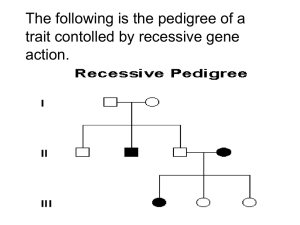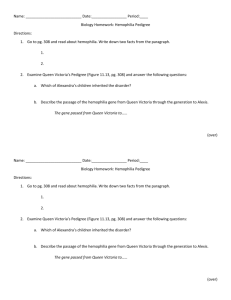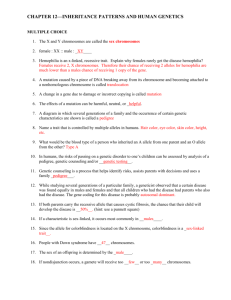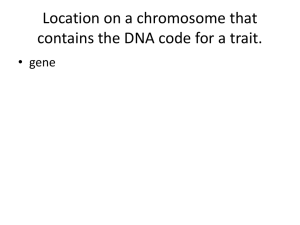Human Pedigree Studies - 2012
advertisement
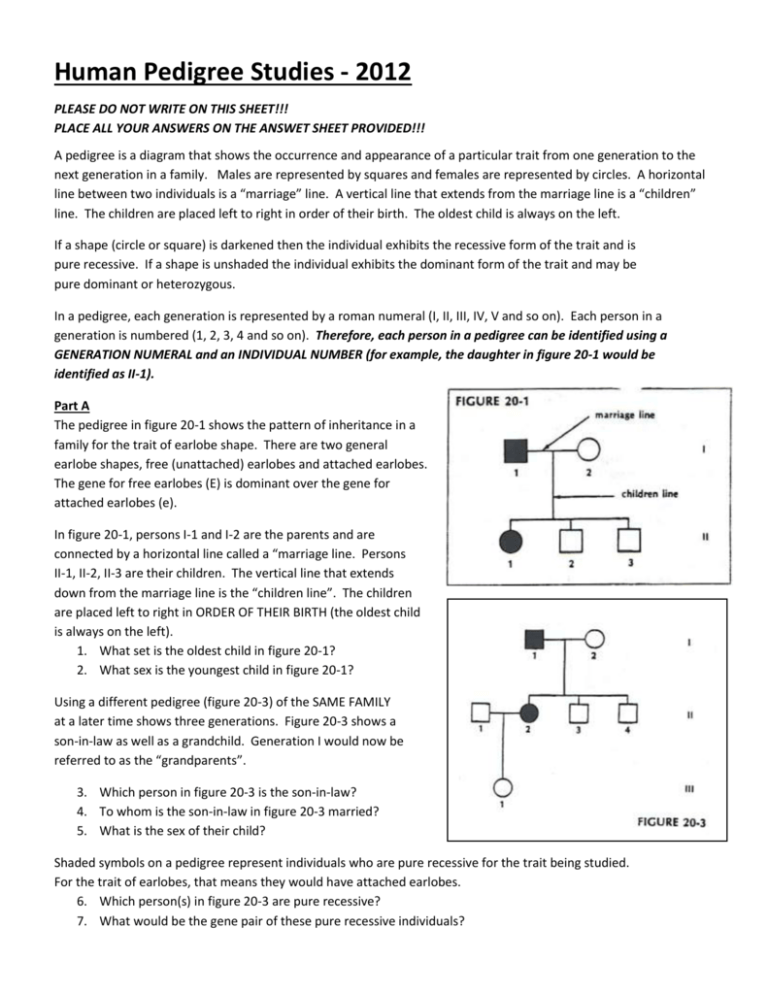
Human Pedigree Studies - 2012 PLEASE DO NOT WRITE ON THIS SHEET!!! PLACE ALL YOUR ANSWERS ON THE ANSWET SHEET PROVIDED!!! A pedigree is a diagram that shows the occurrence and appearance of a particular trait from one generation to the next generation in a family. Males are represented by squares and females are represented by circles. A horizontal line between two individuals is a “marriage” line. A vertical line that extends from the marriage line is a “children” line. The children are placed left to right in order of their birth. The oldest child is always on the left. If a shape (circle or square) is darkened then the individual exhibits the recessive form of the trait and is pure recessive. If a shape is unshaded the individual exhibits the dominant form of the trait and may be pure dominant or heterozygous. In a pedigree, each generation is represented by a roman numeral (I, II, III, IV, V and so on). Each person in a generation is numbered (1, 2, 3, 4 and so on). Therefore, each person in a pedigree can be identified using a GENERATION NUMERAL and an INDIVIDUAL NUMBER (for example, the daughter in figure 20-1 would be identified as II-1). Part A The pedigree in figure 20-1 shows the pattern of inheritance in a family for the trait of earlobe shape. There are two general earlobe shapes, free (unattached) earlobes and attached earlobes. The gene for free earlobes (E) is dominant over the gene for attached earlobes (e). In figure 20-1, persons I-1 and I-2 are the parents and are connected by a horizontal line called a “marriage line. Persons II-1, II-2, II-3 are their children. The vertical line that extends down from the marriage line is the “children line”. The children are placed left to right in ORDER OF THEIR BIRTH (the oldest child is always on the left). 1. What set is the oldest child in figure 20-1? 2. What sex is the youngest child in figure 20-1? Using a different pedigree (figure 20-3) of the SAME FAMILY at a later time shows three generations. Figure 20-3 shows a son-in-law as well as a grandchild. Generation I would now be referred to as the “grandparents”. 3. Which person in figure 20-3 is the son-in-law? 4. To whom is the son-in-law in figure 20-3 married? 5. What is the sex of their child? Shaded symbols on a pedigree represent individuals who are pure recessive for the trait being studied. For the trait of earlobes, that means they would have attached earlobes. 6. Which person(s) in figure 20-3 are pure recessive? 7. What would be the gene pair of these pure recessive individuals? Unshaded symbols represent individuals that have AT LEAST ONE DOMINANT GENE. These persons exhibit the dominant trait of free earlobes. 8. What are the possible gene pairs of individuals that show the dominant trait of free earlobes? 9. If the person in question has two dominant alleles, how would they be described? As hybrid, heterozygous, pure, homozygous or a combination of these? To predict the gene pairs for each person in a pedigree, there are two rules you must follow. These two rules allow you to predict the possible gene pairs for many of the persons in a pedigree. Figure 20-4 (showing the same family) shows the genes predicted by using the following rules. RULE 1 - Assign two recessive alleles to any person whose shape is shaded. These persons exhibit the recessive trait being studied. RULE 2 – Assign one dominant allele to any person whose shape is unshaded. These persons exhibit the dominant trait being studied. To determine the second allele in a pair for persons who show the dominant form of the trait, a testcross is used. In figure 20-4 we already know that the grandfather I-1 has the gene pair ee. 10. If the grandmother I-2 were EE, could any ee children be produced? To help you answer this question complete the Punnett square on your answer sheet. 11. If the grandmother 1-2 were Ee, could any ee children be produced? To help you answer this question complete the Punnett square on your answer sheet. 12. What is the gene pair of the grandmother? 13. What is the gene pair for child II-3? To help answer this question look at the gene pairs of the parents. 14. What is the gene pair for child II-4? To help answer this question look at the gene pairs of the parents. The gene pair of some persons in a pedigree cannot be determined. One such person is the son-in-law, II-1. 15. What are the possible gene pairs of the son-in-law, II-1? 16. Why are we unable to determine his exact gene pair? PART B Complete the Punnett squares on your answer sheet (A, B, C). Examine the pedigree below. 17. Which of the Punnett squares (A, B or C) would best fit this pedigree? 18. Why? Explain your reasoning. PART C Hemophilia is a recessive X-linked disorder found only on the X chromosome. There is no corresponding information on the Y chromosome. For this reason, females are often carries of hemophilia and unknowingly pass hemophilia on to their sons. Because hemophilia is a X-linked disorder it must be represented differently on a Punnett square and a Pedigree. Examine the genotypes (to the right) used when studying the trait of hemophilia. XH XH = normal female XH Xh = normal female, carrier of hemophilia Xh Xh = female with hemophilia XH Y = normal male Xh Y = male with hemophilia Examine the pedigree for Queen Victoria’s family (seen below). 19. 20. 21. 22. 23. 24. 25. 26. 27. How many generations are shown? How many persons had hemophilia? How many persons did not have hemophilia (include carriers)? How many persons were carriers of hemophilia? What sex are the carriers of hemophilia? What are the gene pairs for individuals having hemophila? What is the gene pair for the carriers of hemophilia? Did any of the male offspring with hemophilia have children? Who? If Leupold and his wife had one child who is a carrier for hemophilia, what must the child’s genotype be? PART D Examine the pedigree for Deaf-Mutism. One form of deafness in humans is a type in which the individual inherits not only deafness but also the inability to speak (mute). Use “D” to represent normal hearing and speech and “d” to represent the recessive form of the trait – deaf and mute. 28. 29. 30. 31. 32. 33. 34. 35. How many generations are shown in the pedigree? Do parents I-1 and I-2 have any children that are deaf-mute? What must be the gene pair of parents I-1 and I-2 if they are able to have a deaf-mute child? Is deaf-mutism only found in females? Why do parents III-13 and III-14 have four deaf-mute children? What is be the gene pair of person III-8? Why don’t parents III-8 and III-9 have at least one deaf-mute child? With this information, what must be the gene pair of person III-9? PART E 36. On your answer sheet, draw a pedigree for a family showing 2 parents and four children as follows: (a) make the 2 oldest children boys and the two youngest girls. (b) label the marriage line and the children line (c) label the individuals and the generations with numbers (d) Indicate person II-2 has attached earlobes (e) Fill in the genotypes and symbols to indicate the remaining family’s traits


